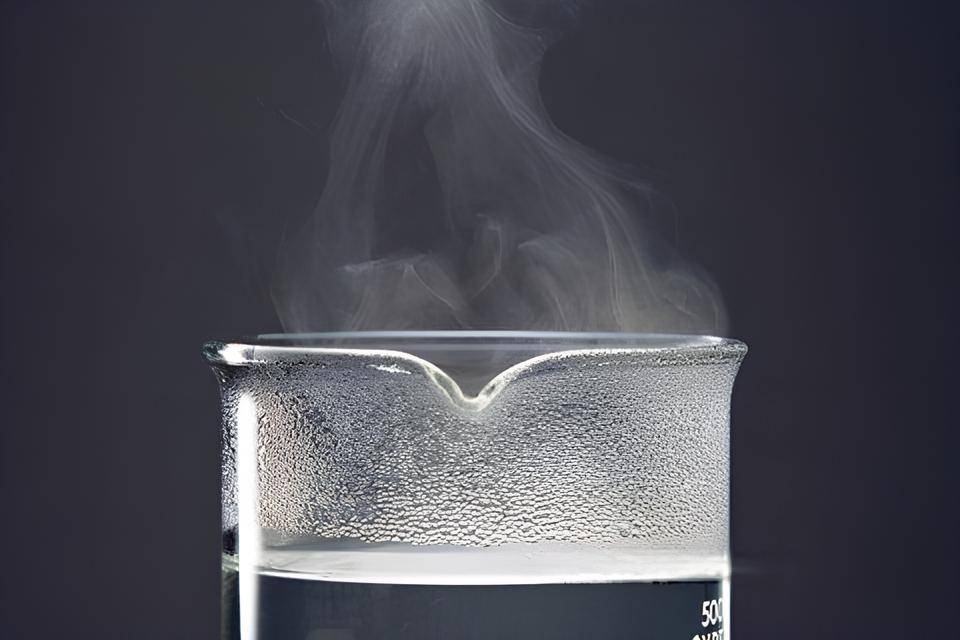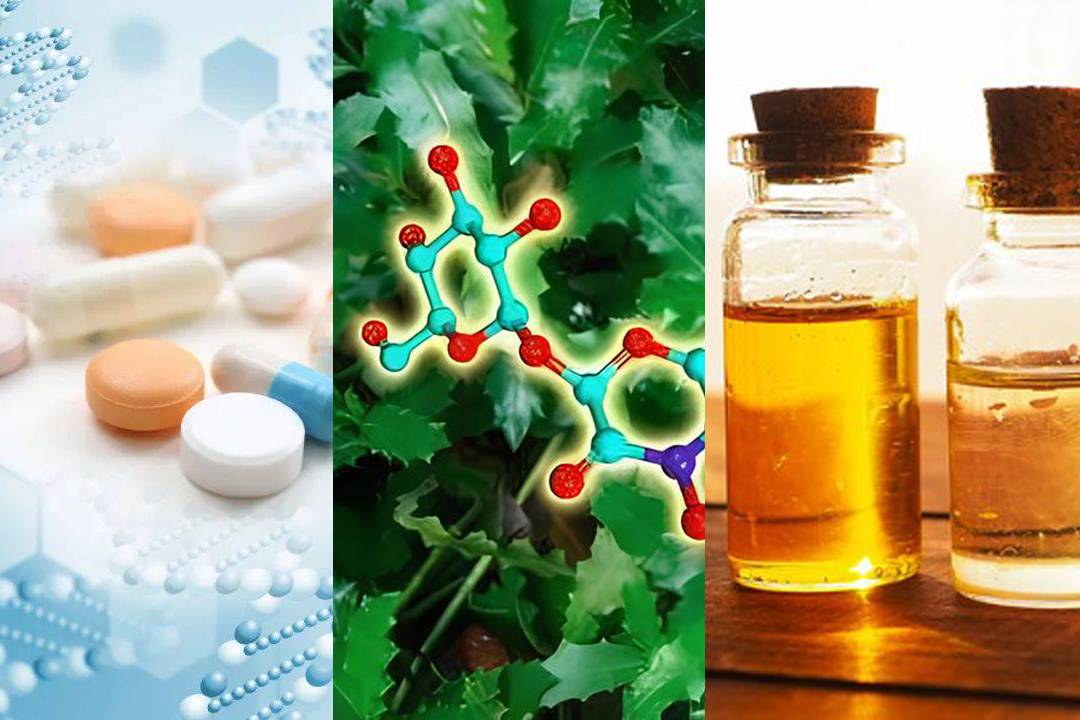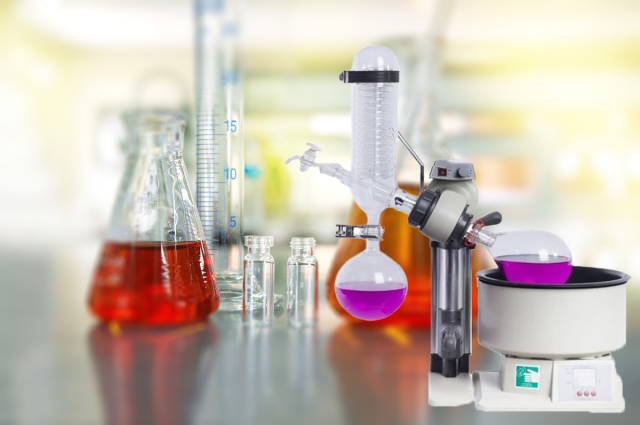Introduction to Rotary Evaporators
Rotary evaporators, or rotovaps, are laboratory equipment used in separation processes to remove solvents from samples. The device works by rotating the sample under vacuum, causing the solvent to evaporate, and then condensing it for collection. The rotary evaporator consists of a heating bath, a rotating flask, and a condenser. This equipment is commonly used in chemistry research, pharmaceuticals, and biotech industries. The use of a rotary evaporator offers several advantages, such as efficient solvent recovery, easy scalability, and low operating costs. However, it also has some drawbacks, such as the need for high vacuum levels and the potential for sample contamination.
Table of Contents
Working Principle of Rotary Evaporators
Rotary evaporators are widely used in laboratories for separating solvents from chemical compounds. The working principle of rotary evaporators is based on the concept of evaporation and condensation of a liquid sample. The sample is placed in a round-bottom flask and heated under vacuum, causing the solvent to evaporate. The evaporated solvent then passes through a cooled condenser where it condenses and is collected in a separate flask. The rotation of the flask during the process ensures that the sample is evenly distributed for maximum surface area exposure, resulting in more efficient evaporation.
Heating and Evaporation Process
The first step of the working principle of rotary evaporators is the heating and evaporation process. The sample is placed in a round-bottom flask, which is then rotated at a constant speed while being heated under vacuum. The vacuum lowers the boiling point of the solvent, resulting in faster and more efficient evaporation. The rotation of the flask ensures that the sample is evenly distributed, allowing for maximum surface area exposure.
Cooling and Condensation Process
The next step of the working principle of rotary evaporators is the cooling and condensation process. The evaporated solvent then passes through a cooled condenser where it condenses and is collected in a separate flask. The cooled condenser is essential in the process as it aids in converting the gas back to a liquid form that needs lower temperatures. The vacuum system also helps to lower the boiling point of the solvent, reducing the risk of thermal degradation of heat-sensitive compounds.
Advantages of Rotary Evaporators
The use of rotary evaporators has numerous advantages in separation processes. Rotary evaporators provide a fast and efficient method for solvent removal, making it a valuable tool for any laboratory that deals with chemical compounds. They are also very versatile and can be used for drying, concentration, crystallization, separation, and solvent recovery in various industries such as chemical, pharmaceutical, and biopharmaceutical industries.
In conclusion, the working principle of rotary evaporators is based on the concept of evaporation and condensation of a liquid sample. They are widely used in laboratories for separating solvents from chemical compounds, especially in the pharmaceutical and chemical industries. Rotary evaporators provide a fast and efficient method for solvent removal, making it a valuable tool for any laboratory that deals with chemical compounds.

Advantages and Disadvantages of Rotary Evaporators
Rotary evaporators are an essential tool in separation processes, offering a highly efficient and precise method for separating substances from solvents. While there are some disadvantages to using rotary evaporators, their many advantages make them an invaluable tool for many scientific fields.
Advantages of Rotary Evaporators
- Lower Boiling Temperatures
- Rotary evaporators work together with a vacuum system to reduce the pressure of the system, allowing for the separation of solvents and other compounds at lower temperatures than usual.
- Faster Evaporation of Solvent
- The rotating flask of the rotary evaporator increases the surface area of the liquid, which leads to faster evaporation.
- The electronic control of the rotation speed creates an even larger surface area, resulting in a significantly increased distillation speed.
- Fewer Operations
- Rotary evaporators have a built-in lifting and falling motor, which enables automatic raising of the rotary bottle to a position just above the water bath for the rotation process. This reduces the technician's involvement in holding the apparatus.
- The motor is electrically powered, making it an efficient and reliable apparatus for most chemistry labs.
- Rotary Evaporators Suppress Bumping
- Due to the forces that contribute to the evaporation process (centripetal force and friction), bumping is often suppressed, allowing for quick and gentle evaporation of mixtures.
- Large Sample Volumes
- Rotary evaporators can handle large volumes of samples at once, making them ideal for industrial-scale separation processes.
- Precise Separation
- Rotary evaporators can be used to separate even the most complex mixtures, making them highly precise.
Disadvantages of Rotary Evaporators
- Cost
- Rotary evaporators can be expensive to purchase and maintain, which may limit their availability to smaller labs or research facilities.
- Operational Complexity
- The process of separating substances using a rotary evaporator can be time-consuming and complex, requiring skilled technicians to operate the equipment safely and effectively.
- Cleaning Requirements
- The glassware of the rotary evaporator needs to be cleaned very often to ensure the purity of the extracted materials. This can be time-consuming and may require specialized cleaning techniques.
In conclusion, while rotary evaporators have some disadvantages, their many advantages make them an essential tool for separation processes in many scientific fields. They are highly efficient, precise, and can handle large volumes of samples at once, making them ideal for industrial-scale separation processes.

Functions of Rotary Evaporators
Rotary evaporators are essential equipment in laboratories for separating solvents from a mixture of compounds. The instrument uses a rotating flask, a heating bath, and a vacuum system to evaporate and recover solvents efficiently. The rotary evaporator has several functions, including:
Removal of Solvents from Chemical and Biological Samples
One of the primary functions of a rotary evaporator is to remove solvents from chemical and biological samples. The instrument's vacuum system lowers the boiling point of the solvent, which then evaporates in the rotating flask. The evaporated solvent is then condensed and collected in a separate flask. The process is repeated until the desired level of solvent removal is achieved. The rotary evaporator's ability to remove solvents efficiently makes it an indispensable tool in laboratory research.
Isolation and Purification of Natural Products
Rotary evaporators are used in the isolation and purification of natural products. The process involves extracting the desired compounds from a mixture of natural products. The rotary evaporator's vacuum system, combined with its ability to rotate the sample, provides a high level of precision and speed in the separation of natural products, making it an essential tool in natural product research.
Preparation of Samples for Analysis
Rotary evaporators are also used in the preparation of samples for analysis. Before analysis, samples often require concentration and purification. The rotary evaporator removes the solvent from the sample, leaving behind the desired compound. The process ensures that the sample is in a concentrated form, making it easier to analyze.
Other Applications
Rotary evaporators are also used in other fields, including pharmaceuticals, chemistry, and food and beverage industries. The instrument's ability to provide a high level of precision and speed in solvent separation makes it a valuable tool in laboratory research. In the food and beverage industry, rotary evaporators are used to extract flavors and aromas from various ingredients, including herbs, fruits, and spices.
In summary, the rotary evaporator is an essential instrument in laboratory research. Its ability to remove solvents, isolate and purify natural products, prepare samples for analysis, and extract flavors and aromas make it a valuable tool in various fields.
How Rotary Evaporators Work
Rotary evaporators, also known as rotovaps, are essential for separation processes in various industries, including pharmaceuticals, chemical, and food processing. These devices work by evaporating solvents from complex mixtures, leaving behind concentrated samples of interest.
The Basic Principle
The basic principle of rotary evaporation is to increase the sample’s surface area and optimize its temperature and vacuum level to enable effective solvent separation in as little time as possible. The process of rotary evaporation is gentle and efficient, making it an excellent method for liquid separation and purification.
Equipment Involved
Two separate pieces of equipment are at the heart of a rotary evaporation system – a rotary evaporator and a vacuum pump. The rotary evaporator consists of a heated water bath, a rotating evaporation flask that contains the mixture to be separated, and a chilled condenser with a condensate collection flask. The vacuum pump is a separate unit connected to the rotary evaporator on the condenser side via vacuum tubing.
The Process
The evaporation flask with the mixture of substances is first immersed in the heated water bath. The rotation and shape of the flask result in better heat distribution and a greater surface area than in a distillation column, accelerating the evaporation process. By adding heat and reducing the pressure inside the rotary evaporator through the vacuum pump, the substance with a lower boiling point evaporates.
The vapor travels to the cooled condenser and condenses there, changing from the gaseous state to the liquid state again and collected in the receiving flask below the condenser. The desired product remains isolated in the evaporation flask, typically in the form of a solid or a concentrated solution.
Key Benefits
Rotary evaporators offer several key benefits. They allow users to carry out solvent removal faster and more efficiently than evaporation under atmospheric pressure, saving time and increasing productivity in the laboratory. The film’s formation on the flask’s inner surface increases evaporation significantly, making it relatively quick to achieve solvent removal depending on volume and solvent. Rotary evaporators are simple to use and commonly found in laboratories.
Selecting the Optimal Vacuum Pump
Considerations for selecting the optimal vacuum pump include oil-free operation with excellent chemical compatibility, the ability to process wet vapors, ultimate depth of vacuum, flow rate in proportion to the system volume, solvent recovery options at both the inlet and the outlet, and adjustable control of vacuum levels.
The Delta 20 Rule
When setting up an evaporation process in a rotary evaporator, the “Delta 20” rule of thumb can help optimize the evaporation. The Delta 20 rule refers to the temperature gradients between the heating bath, solvent vapor, and the condenser. The effective vapor temperature is approximately 20°C lower than the set temperature at the heating bath, as the evaporation process gives off energy and heat from the liquid mixture. For efficient condensation, the cooling temperature at the condenser should be at least 20°C lower than the effective vapor temperature.
In conclusion, rotary evaporators are an essential tool for separation processes in various industries. They work by evaporating solvents from complex mixtures, leaving behind concentrated samples of interest. By understanding the basic principle, equipment involved, process, key benefits, selecting the optimal vacuum pump, and the Delta 20 rule, users can optimize the evaporation process and achieve efficient and selective separation of compounds, resulting in a purer sample.
Applications of Rotary Evaporators in Separation Processes
Rotary evaporators, or rotovaps, are widely used in separation processes for various applications. These include:

Purification of drugs
Rotary evaporators are widely used in the pharmaceutical industry for the purification of drugs. They are used to separate and purify compounds, such as solvents, inorganic salts, and acids. The low boiling point effect of rotary evaporators on solvents makes it easy to work with various chemicals and chemical solvents in creating valuable pharmaceutical products at an affordable cost.
Distillation of plant extracts
The distillation of plant extracts is another application of rotary evaporators in separation processes. Rotary evaporators are ideal for the separation of essential oils from plant extracts. They are used to extract essential oils from plants and other natural sources. The essential oils are then used in the production of fragrances, flavors, and cosmetics.
Isolation of natural products
Rotary evaporators are also used in the isolation of natural products. They are used to separate and purify compounds from natural sources, such as plant extracts, animal tissues, and microorganisms. The isolation of natural products is important for the development of new drugs and chemicals.
Concentration of flavors and fragrances
Rotary evaporators are widely used in the food industry for the concentration of flavors and fragrances. They are used to concentrate fresh and pure flavors from fruits, herbs, and alcoholic drinks by getting rid of water. This makes it possible to obtain the desired flavor from different mixtures at incredibly low temperatures.
Separation of solvents
Rotary evaporators are also used in the chemical industry for the separation of solvents. They are used to separate solvents from various polymeric, organic, and inorganic materials. This makes it easy for scientists to design pharmaceutical drugs and other chemical products.
In conclusion, rotary evaporators are essential tools in separation processes, providing a reliable and efficient means of purifying and isolating compounds. Their versatility and ease of use make them a popular choice for researchers and scientists in various fields.
Related Products
Related Articles
- How to Choose Laboratory Vacuum Pumps for Maximum Efficiency and Cost Savings
- Choosing the Right Rotary Vacuum Evaporator for Your Lab
- Common Mistakes to Avoid When Using a Rotary Vacuum Evaporator
- How to Choose the Best Rotary Evaporator (Rotavapor) for Your Budget
- A Step-by-Step Guide to Using a Rotary Vacuum Evaporator for Solvent Removal

